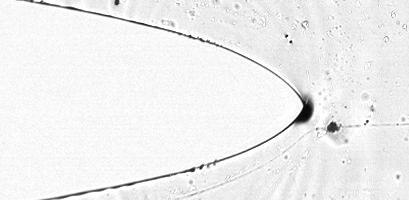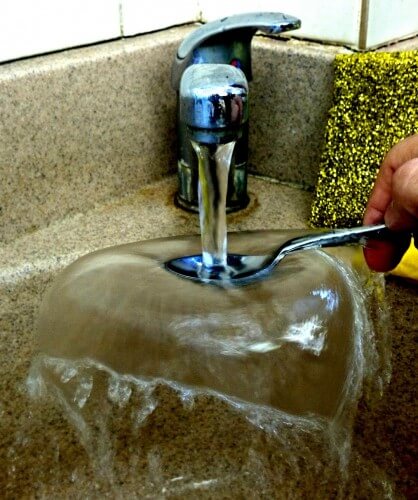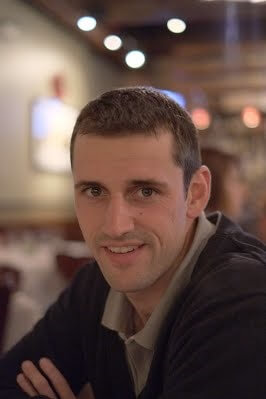Dr. John Kolinsky, a Milgai Fulbright who is doing a post-doctorate in the laboratories of Professors J. Feinberg and Eran Sharon researches basic physical processes that can be sensed

The field of classical experimental physics sounds so 19th century or so school experiments, that in fact most physicists have abandoned it. However, it turns out that there is still much to explore in tangible phenomena, and not only in subatomic particles, quantum physics or astrophysics, whose honor is of course in its place, also on this site.
Dr. John Kolinsky, who completed his doctorate last year at Harvard University, is currently conducting post-doctoral research in the laboratories of Prof. J. Feinberg and Prof. Eran Sharon at the Hebrew University. Academic-scientific partnership between the USA and Israel and supports outstanding researchers and research students. Fulbright program Managed by the USA-Israel Education Foundation and is the first intergovernmental program to promote scientific ties between Israel and the USA.
Fractures are a phenomenon we are all familiar with, many materials - such as glass, break when pressure is applied to them. One of the problems is that the speed at which a crack spreads throughout the material and causes it to break is so high that it is difficult to capture and study.
Fractures are a source of damage and danger. When you want to build a bridge or a building, which will remain intact and not fall apart, you must understand the dynamics of the propagation of fractures. To examine how the fracture spreads, Kolinsky and his colleagues in Feinberg's laboratory prepared thin sheets made of a certain type of gel that, when stretched or dropped, shatters like glass. However, this particular gel was chosen because the speed of sound through it is a thousand times slower than in materials such as glass. There is a relationship between the speed of sound in a material and the speed of crack propagation.
"In this way we manage to slow down the process. It is still a very fast process for the human eye, but the dynamics of the fractures can be studied using high-speed imaging systems."
"The physics of the process can be explained quite simply: a fracture starts from a single point of failure in the material. In our case we took a knife and made a scratch in the gel sheet. The pressures cause the forces to concentrate at one point. The material will break from this point and the fracture will spread over its entire surface.
In response to the question of why investigate the system with thin sheets, when most of the materials that break are much thicker, Kolinski explained that thin sheets constitute a system that makes it possible to create an ideal fracture and compare the results with those predicted by the theories of fracture mechanics. In a thicker material there are many influencing factors, so it is more difficult to study them, although the governing physics is the same physics.
"We have a way to control defects or inhomogeneities in the gel. Now we examine how the process changes when there are more or less defects in the material. This will give us a way to assess how fractures propagate through a non-ideal material."
"I am not the first to work on fracture mechanics in Feinberg's laboratory. The researchers before me, including Eran Sharon, who did his doctorate with Feinberg and later opened his own laboratory, discovered several islands that occur when the fracture moves within the material. "
Sobi Sobi from a sprinkler

In a separate project, Kolinsky, together with Feinberg and Sharon, investigates sheets of a different type - sheets of liquid. To illustrate what this is about, you just need to wash dishes, especially a spoon. Place a spoon under an open faucet and you will see that a surface of water forms around the spoon, and as you move away from the spoon, it faces the sink and turns into separate drops of water.
"We are interested in the question of what happens when the target (for example the spoon) moves, when the drops are formed in this case compared to a situation where the target remains stable."
It may seem like an intellectual curiosity, but as in the case of the fragments, here too there are consequences. Sheets of liquid become droplets in the combustion chamber of the car engine, near the water outlet from the sprinkler.
"We have a jet of liquid and when it hits the target, a sheet of water is created. One of the interesting things about this process is that the sheet eventually breaks down into drops. This process is called ATOMZATION (it has nothing to do with the atoms of a substance, but here the word is used to explain the transformation of the sheet of water into individual drops).
"Moving the target causes the formation of drops of different sizes and possibly also shortening the duration, this causes the sheet to disintegrate sooner. As mentioned, there are many applications where liquids are transferred in a certain medium and you want to see what happens with different droplet sizes. The fuel droplets in the combustion chamber in the car do their job efficiently when the droplets are of a certain size. The same is true when you want to move water in a uniform and efficient way in the garden. That is why it is important to study the physics governing these processes."
"I have always been interested in applied classical physics. During my doctorate at Harvard, I came to Israel to research together with a former colleague - Prof. Shmuel Rubinstein who was then working at the Weizmann Institute. When I finished my doctorate, I decided to do a post-doctorate in Israel. The whole idea of a PhD is to provide you with an opportunity to broaden your exposure to other research problems and learn new things.
"Knowing the academic environment here, it is lively and strong, and also because I really enjoyed my stay in Israel until that time, I started looking for opportunities to complete a doctorate in Israel. "
"I finished my doctorate at Harvard, and I knew I wanted to continue with classical experimental physics, and it turned out that Jay Feinberg and Eran Sharon are world-class experts in classical experimental physics. That's why it seems logical to me to look for an opportunity to work with them and learn in depth the experimental classical physics."
"The Fulbright Israel program has an excellent program in which they offer financial assistance for two years to those who wish to do a post-doctorate in Israel. At this point, I applied for a scholarship in the Fulbright program to support my projects in Israel. In addition to the financial support, the Fulbright program provides an opportunity to travel to Israel and learn more about the country, as well as to meet people from different academic backgrounds who are also related to the Fulbright program and learn what they are researching."

Dr. John Kolinsky will be a guest on Thursday 12.3 at the conference for advanced degrees in science in the USA of the counseling center Education USA- The US-Israel Education Fund, which will be held in Tel Aviv, with the participation of Israeli graduates and American researchers from Stanford, Yale, MIT, NYU and more. The conference is free of charge, but advance registration is required: 03-5172131 extension 200
